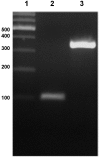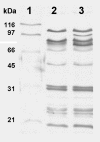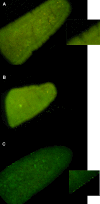Protection of rabbits against enteropathogenic Escherichia coli (EPEC) using an intimin null mutant
- PMID: 16796739
- PMCID: PMC1544329
- DOI: 10.1186/1746-6148-2-22
Protection of rabbits against enteropathogenic Escherichia coli (EPEC) using an intimin null mutant
Abstract
Background: Diarrhea and mortality resulting from infections with enteropathogenic Escherichia coli (EPEC) are of major economic importance in the rabbit meat industry. There is a growing need for an effective vaccine to cope with these problems and to reduce the use of antibiotics. EPEC are characterized by an attaching and effacing virulence mechanism. This is partly mediated by the intimate binding between an adhesin, called intimin, and a translocated receptor (Tir) of prokaryote origin. We constructed an intimin deletion mutant of the rabbit EPEC (REPEC) wild-type strain 97/241.6 (bio-/serogroup 3-/O15) and examined its protective capacity.
Results: After verifying its complete loss of virulence, we used the attenuated strain in vaccination-challenge experiments in which complete protection against a homologous, but virulent, strain was observed. The attenuated strain was able to persist in the intestinal lumen, where it elicited an immune response against EPEC-related virulence proteins, as was shown using an EspB-specific ELISA. Despite the priming of an immune response and the generation of specific antibodies, the intimin mutant was not able to fully protect rabbits against challenges with REPEC strains of other bio-/serogroups.
Conclusion: These data indicate that protection against REPEC infections is at least partly bio-/serogroup dependent and a multivalent vaccine may be needed for protection against the full range of REPEC types. Such a combination vaccine may be developed using intimin null mutants, as the latter were clearly shown to be safe and effective against homologous infections.
Figures








Similar articles
-
A directed intimin insertion mutant of a rabbit enteropathogenic Escherichia coli (REPEC) is attenuated, immunogenic and elicits serogroup specific protection.Vet Immunol Immunopathol. 2013 Mar 15;152(1-2):146-55. doi: 10.1016/j.vetimm.2012.09.035. Epub 2012 Sep 27. Vet Immunol Immunopathol. 2013. PMID: 23084628
-
Towards a vaccine for attaching/effacing Escherichia coli: a LEE encoded regulator (ler) mutant of rabbit enteropathogenic Escherichia coli is attenuated, immunogenic, and protects rabbits from lethal challenge with the wild-type virulent strain.Vaccine. 2006 May 1;24(18):3845-55. doi: 10.1016/j.vaccine.2005.07.019. Epub 2005 Jul 28. Vaccine. 2006. PMID: 16112258
-
Protection against hemorrhagic colitis in an animal model by oral immunization with isogeneic rabbit enteropathogenic Escherichia coli attenuated by truncating intimin.Infect Immun. 2005 Oct;73(10):6608-19. doi: 10.1128/IAI.73.10.6608-6619.2005. Infect Immun. 2005. PMID: 16177337 Free PMC article.
-
[Enteropathogenic Escherichia coli from the rabbit].Ann Rech Vet. 1992;23(1):27-48. Ann Rech Vet. 1992. PMID: 1510337 Review. French.
-
Rabbit EPEC: a model for the study of enteropathogenic Escherichia coli.Vet Res. 1999 Mar-Jun;30(2-3):203-19. Vet Res. 1999. PMID: 10367355 Review.
Cited by
-
Digestive problems in rabbit production: moving in the wrong direction?Front Vet Sci. 2024 Feb 7;11:1354651. doi: 10.3389/fvets.2024.1354651. eCollection 2024. Front Vet Sci. 2024. PMID: 38384954 Free PMC article.
-
Recent advances in understanding enteric pathogenic Escherichia coli.Clin Microbiol Rev. 2013 Oct;26(4):822-80. doi: 10.1128/CMR.00022-13. Clin Microbiol Rev. 2013. PMID: 24092857 Free PMC article. Review.
References
-
- Elliott SJ, Wainwright LA, McDaniel TK, Jarvis KG, Deng YK, Lai LC, McNamara BP, Donnenberg MS, Kaper JB. The complete sequence of the locus of enterocyte effacement (LEE) from enteropathogenic Escherichia coli E2348/69. Mol Microbiol. 1998;28:1–4. doi: 10.1046/j.1365-2958.1998.00783.x. - DOI - PubMed
-
- Batchelor M, Prasannan S, Daniell S, Reece S, Connerton I, Bloomberg G, Dougan G, Frankel G, Matthews S. Structural basis for recognition of the translocated intimin receptor (Tir) by intimin from enteropathogenic Escherichia coli. EMBO J. 2000;19:2452–2464. doi: 10.1093/emboj/19.11.2452. - DOI - PMC - PubMed
-
- Deibel C, Dersch P, Ebel F. Intimin from Shiga toxin-producing Escherichia coli and its isolated C- terminal domain exhibit different binding properties for Tir and a eukaryotic surface receptor. Int J Med Microbiol. 2001;290:683–691. - PubMed
Publication types
MeSH terms
Substances
LinkOut - more resources
Full Text Sources
Medical

